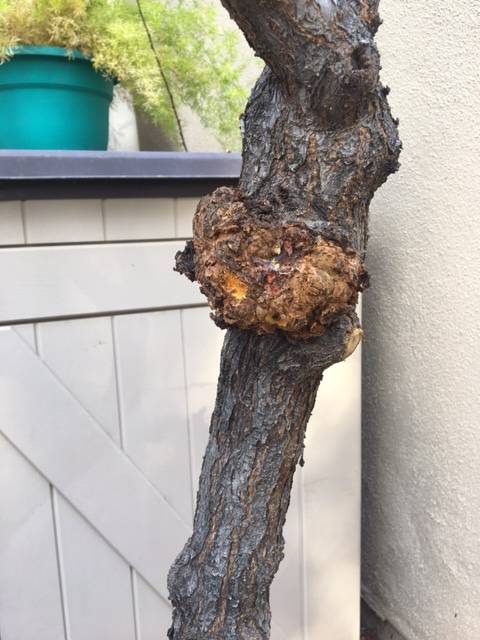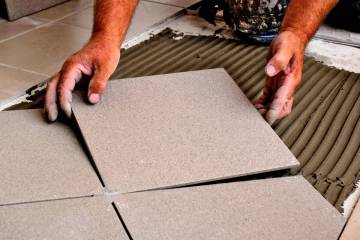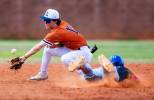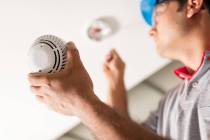It’s not too late to prune fruit trees in Las Vegas
If you haven’t pruned your fruit trees yet, it’s not too late. Prune grapes as late as possible — toward the end of February or the first week of March in the Las Vegas Valley. More will be coming on grapes in the coming weeks.
Final pruning of fruit trees for less-experienced pruners is best delayed until flowers appear. It’s a lot easier to see where fruit will be produced when actual flowers are seen.
Pruning fruit trees is a two-step process. The first step controls the size of older trees and trains the developing major limbs of younger trees to support smaller branches and fruit. The second step in pruning focuses on spreading fruit production throughout the entire tree’s canopy.
The first step is done anytime after leaf drop in the fall but before flower and fruit production in early spring. As soon as the tree is pruned for size and major limb selection is established, apply dormant oil sprays for preventing many different types of insect damage in the coming months. Do this before flowering starts.
The two steps can be done separately or at the same time. I suggest two separate steps for the less experienced.
During the first three years after planting, the focus is on developing the tree’s structure. While the tree is in its first three years, major limbs are trained by directing the limbs to grow at 45-degree angles from the ground. Ninety percent of pruning efforts during the first season focus on establishing the overall tree structure, about 50 percent the second season and about 10 percent the third season.
Once the overall structure of the tree is established, very little of this type of pruning needs to be done in the future. From that point forward, pruning is focused on fruit production. Pruning to control its size is done when the tree is over 4 or 5 years old.
On peach and nectarine, fruit production should come from all parts along the scaffold limbs, not just the tips. Pruning for fruit production focuses on developing young, newer growth horizontally like a feather, with plenty of space between branches to allow indirect light inside the tree canopy. That means removing most upward and downward growth.
In the Mojave Desert, because of our hot, bright summer sun, the focus is on finding a balance between shading the limbs inside the tree and its trunk and opening the canopy for more light. That balances the tree’s need for sunlight with its potential damage.
Q: I pruned some fruit-laden heavy branches from my semi-dwarf nectarine tree during the hot summer months last year. I think I’ve damaged the tree. The leaves on a few branches turned yellow/orange while 80 percent of the other leaves look dead. Should I do some heavy pruning, or wait and see?
A: Leave the tree unpruned this season to protect it as much as possible. Let it send up lots of new growth this spring and hope for the best.
Right now, the tree needs to shade its larger limbs and trunk to help prevent sunburn and prevent borers from attacking the tree. Scientists report that borers love to attack peach and nectarine trees where intense sunlight has damaged them. Borers are not controlled by winter sprays of horticultural oil.
Paint the upper surface of exposed large limbs and the south and west sides of the trunk with diluted white latex paint. Painting or covering these areas helps reduce sunburn.
Sunburn results from intense sunlight shining on exposed areas. Painting exposed surfaces of the tree with any light-colored latex paint mixed half-and-half with water helps reduce this damage. It won’t eliminate its possibility but helps to reduce it.
As a precaution, drench the soil around the tree with a systemic insecticide for borer control. Do this immediately after the tree finishes flowering this spring.
Don’t eat the fruit, produced this season, from this tree because the insecticide is systemic and probably inside the fruit. Most of it will be gone from the tree by the next growing season. Follow the label directions exactly.
Next season remove major limbs only during the winter months and always remove fruit from your tree when it’s tiny so as to reduce limb breakage.
Q: I have a Meyer lemon tree that needs pruning. How do you suggest I should proceed?
A: Older citrus, including Meyer lemon, needs little pruning after it’s over about 4 or 5 years old if it’s been trained properly. When young, it should be trained to grow into a tree.
The same structure used for training other fruit trees is applied to citrus. The central trunk has limbs removed from its trunk or multiple trunks up to about knee height. Limbs are removed from the trunk so that heavy fruit still attached to the remaining limbs doesn’t wind up sitting on the ground. Fruit touching the ground is more likely to spoil.
While it’s still young, develop the main scaffold limbs that support new growth and fruit. Thescaffold limbs should grow from the trunk or trunks like spokes on a wheel.
Make sure these major limbs have at least 6 inches between them, originate in a spiral pattern from the trunk and are not growing on top of one another. When limbs grow on top of one another, then shading and light distribution throughout the canopy is a problem.
I always start inspecting the trees for good limb distribution at the bottom, usually on my hands and knees. First, I inspect the trunk up to my knees and make sure it’s clean. Next, I inspect the limb structure from my knees to my waist and make sure these scaffold limbs are well distributed. I fix any stems that are crossing over each other, broken or creating too much shade.
If the tree is too tall, I remove upright branches that contribute to its height. The pruning cuts are made inside the canopy at crotches where two or more limbs come together.
Finally, I inspect the tree up to its top, looking for the same types of problems as before. After the structure of the tree is inspected, I then fix any problems with light distribution inside the canopy. After the fourth or fifth year, little pruning of citrus is needed.
Q: How often do you sanitize your pruning shears and what do you use?
A: The primary reason I start my pruning day with an alcohol spray or alcohol wipes applied to pruning blades is for sanitary reasons. First, I clean the blades with soap and water and then sanitize them when finished. Chances are probably one in 500 that it’s not needed, but it’s that one case in 500 where sanitation is important because of diseases.
I usually only sanitize the blades of my hand shears and loppers. I sanitize the saw blade only when it’s needed, which is seldom if I prune every year.
I start pruning with loppers first and finish pruning with my hand shears. Once the lopper blades have been sanitized, they are never placed on the ground again. There are at least five plant disease problems found in soil. Instead, the loppers are hung around my neck or on a limb of the next tree I will be pruning.
If a tree looks like it may have a disease problem, I sanitize equipment that I use after I finish pruning. If it’s a highly virulent disease like fire blight, the blades are sanitized between each pruning cut.
Q: I have a woody cancerous growth coming from my peach tree trunk. Should I remove it or leave it alone?
A: Judging from the pictures you sent, this woody growth looks like the early stage of bacterial crown gall disease. When the tree is older, the cancer-like growth can get quite large, but it’s nothing to get overly excited about. It’s not a deadly disease like fire blight can be, but it does cause a gall-like growth of woody tissue near the point of infection.
Sometimes it’s seen as a gall on the trunks of infected trees that were nicked with a dirty shovel that contacted the soil. In any case, break off this ball from the tree when it gets larger. It will grow back again.
Bob Morris is a horticulture expert and professor emeritus of the University of Nevada, Las Vegas. Visit his blog at xtremehorticulture.blogspot.com. Send questions to Extremehort@aol.com.





























